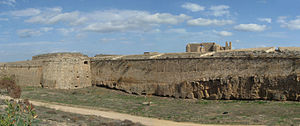Siege of Famagusta
| Siege of Famagusta | |||||||||
|---|---|---|---|---|---|---|---|---|---|
| Part of the Fourth Ottoman–Venetian War | |||||||||
 Venetian Walls of S. Luca ("Bastioni San Luca") in Famagusta |
|||||||||
|
|||||||||
| Belligerents | |||||||||
|
|
|
||||||||
| Commanders and leaders | |||||||||
|
Marco Antonio Bragadin |
Lala Kara Mustafa Pasha | ||||||||
| Strength | |||||||||
| 8,500 | more than 200,000 | ||||||||
| Casualties and losses | |||||||||
| entire army killed and captured | 50,000 | ||||||||
The Siege of Famagusta happened in Venetian-controlled Famagusta, the last Christian possession in Cyprus. Famagusta fell to the Ottomans in August 1571 after a siege that lasted nearly a year.
The large and wealthy island of Cyprus had been under Venetian rule since 1489. Together with Crete, it was one of the major overseas possessions of the Republic. Its population in the mid-16th century is estimated at 160,000. Aside from its location, which allowed the control of the Levantine trade, the island possessed a profitable production of cotton and sugar.
The defences of Cyprus, Crete, Corfu and other Venetian possessions were upgraded in the 1560s, employing the services of the noted military engineer Sforza Pallavicini. Their garrisons were increased, and attempts were made to make the isolated holdings of Crete and Cyprus more self-sufficient by the construction of foundries and gunpowder mills. However, it was widely recognized that, unaided, Cyprus could not hold for long. Its exposed and isolated location so far from Venice, surrounded by Ottoman territory, put it "in the wolf's mouth" as one contemporary historian wrote. In the event, lack of supplies and even gunpowder would play a critical role in the fall of the Venetian forts to the Ottomans. Venice could also not rely on help from the major Christian power of the Mediterranean, Habsburg Spain, which was embroiled in the suppression of the Dutch Revolt and domestically against the Moriscos. Another problem for Venice was the attitude of the island's population. The harsh treatment and oppressive taxation of the local orthodox Greek population by the Catholic Venetians had caused great resentment, so that their sympathies generally lay with the Ottomans.
The Turks decided to conquer Cyprus and on 27 June 1570 the invasion force, some 350–400 ships and 80,000–150,000 men, set sail for Cyprus. They besieged and destroyed the capital Nicosia and other Venetian fortifications. The incomplete Venetian walls of Nicosia were of no use in stopping the powerful Ottoman Army, which was reinforced in the last months of 1570.
On 15 September 1570 the Turkish cavalry appeared before the last Venetian stronghold in Cyprus, Famagusta. At this point already, overall Venetian losses (including the local population) were estimated by contemporaries at 56,000 killed or taken prisoner. The Venetian defenders of Famagusta numbered about 8,500 men with 90 artillery pieces and were commanded by Marco Antonio Bragadin. They would hold out for 11 months against a force that would come to number more than 200,000 men, with 145 guns, providing the time needed by the Pope to cobble together an anti-Ottoman league from the reluctant Christian European states.
...
Wikipedia
